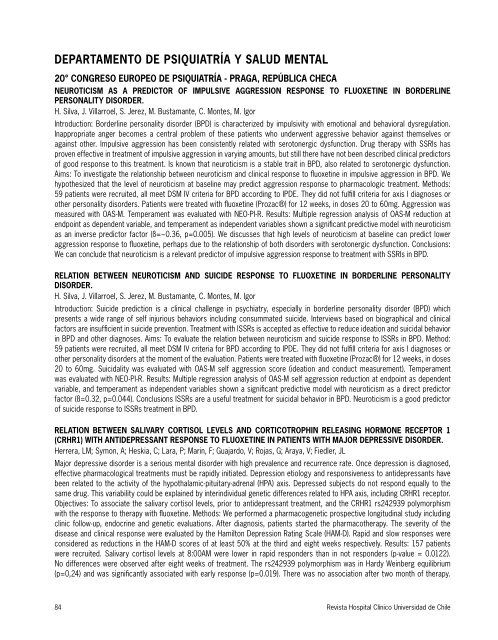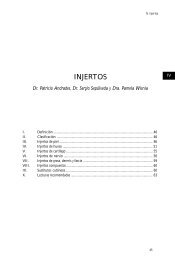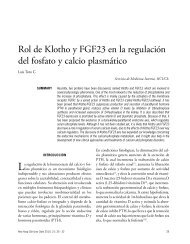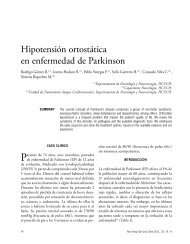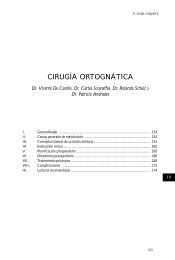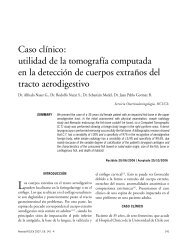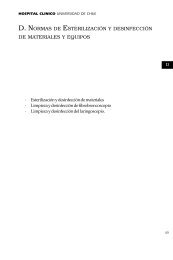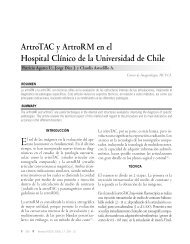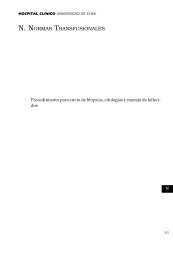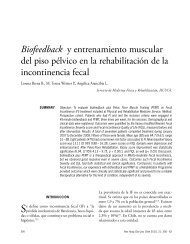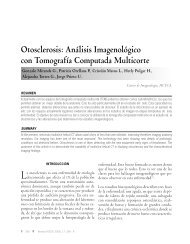Abstracts de trabajos presentados en congresos internacionales 2012
Abstracts de trabajos presentados en congresos internacionales 2012
Abstracts de trabajos presentados en congresos internacionales 2012
You also want an ePaper? Increase the reach of your titles
YUMPU automatically turns print PDFs into web optimized ePapers that Google loves.
DEPARTAMENTO DE PSIQUIATRÍA Y SALUD MENTAL20° CONGRESO EUROPEO DE PSIQUIATRÍA - PRAGA, REPÚBLICA CHECANEUROTICISM AS A PREDICTOR OF IMPULSIVE AGGRESSION RESPONSE TO FLUOXETINE IN BORDERLINEPERSONALITY DISORDER.H. Silva, J. Villarroel, S. Jerez, M. Bustamante, C. Montes, M. IgorIntroduction: Bor<strong>de</strong>rline personality disor<strong>de</strong>r (BPD) is characterized by impulsivity with emotional and behavioral dysregulation.Inappropriate anger becomes a c<strong>en</strong>tral problem of these pati<strong>en</strong>ts who un<strong>de</strong>rw<strong>en</strong>t aggressive behavior against themselves oragainst other. Impulsive aggression has be<strong>en</strong> consist<strong>en</strong>tly related with serotonergic dysfunction. Drug therapy with SSRIs hasprov<strong>en</strong> effective in treatm<strong>en</strong>t of impulsive aggression in varying amounts, but still there have not be<strong>en</strong> <strong>de</strong>scribed clinical predictorsof good response to this treatm<strong>en</strong>t. Is known that neuroticism is a stable trait in BPD, also related to serotonergic dysfunction.Aims: To investigate the relationship betwe<strong>en</strong> neuroticism and clinical response to fluoxetine in impulsive aggression in BPD. Wehypothesized that the level of neuroticism at baseline may predict aggression response to pharmacologic treatm<strong>en</strong>t. Methods:59 pati<strong>en</strong>ts were recruited, all meet DSM IV criteria for BPD according to IPDE. They did not fulfill criteria for axis I diagnoses orother personality disor<strong>de</strong>rs. Pati<strong>en</strong>ts were treated with fluoxetine (Prozac®) for 12 weeks, in doses 20 to 60mg. Aggression wasmeasured with OAS-M. Temperam<strong>en</strong>t was evaluated with NEO-PI-R. Results: Multiple regression analysis of OAS-M reduction at<strong>en</strong>dpoint as <strong>de</strong>p<strong>en</strong><strong>de</strong>nt variable, and temperam<strong>en</strong>t as in<strong>de</strong>p<strong>en</strong><strong>de</strong>nt variables shown a significant predictive mo<strong>de</strong>l with neuroticismas an inverse predictor factor (ß=−0.36, p=0.005). We discusses that high levels of neuroticism at baseline can predict loweraggression response to fluoxetine, perhaps due to the relationship of both disor<strong>de</strong>rs with serotonergic dysfunction. Conclusions:We can conclu<strong>de</strong> that neuroticism is a relevant predictor of impulsive aggression response to treatm<strong>en</strong>t with SSRIs in BPD.RELATION BETWEEN NEUROTICISM AND SUICIDE RESPONSE TO FLUOXETINE IN BORDERLINE PERSONALITYDISORDER.H. Silva, J. Villarroel, S. Jerez, M. Bustamante, C. Montes, M. IgorIntroduction: Suici<strong>de</strong> prediction is a clinical chall<strong>en</strong>ge in psychiatry, especially in bor<strong>de</strong>rline personality disor<strong>de</strong>r (BPD) whichpres<strong>en</strong>ts a wi<strong>de</strong> range of self injurious behaviors including consummated suici<strong>de</strong>. Interviews based on biographical and clinicalfactors are insuffici<strong>en</strong>t in suici<strong>de</strong> prev<strong>en</strong>tion. Treatm<strong>en</strong>t with ISSRs is accepted as effective to reduce i<strong>de</strong>ation and suicidal behaviorin BPD and other diagnoses. Aims: To evaluate the relation betwe<strong>en</strong> neuroticism and suici<strong>de</strong> response to ISSRs in BPD. Method:59 pati<strong>en</strong>ts were recruited, all meet DSM IV criteria for BPD according to IPDE. They did not fulfill criteria for axis I diagnoses orother personality disor<strong>de</strong>rs at the mom<strong>en</strong>t of the evaluation. Pati<strong>en</strong>ts were treated with fluoxetine (Prozac®) for 12 weeks, in doses20 to 60mg. Suicidality was evaluated with OAS-M self aggression score (i<strong>de</strong>ation and conduct measurem<strong>en</strong>t). Temperam<strong>en</strong>twas evaluated with NEO-PI-R. Results: Multiple regression analysis of OAS-M self aggression reduction at <strong>en</strong>dpoint as <strong>de</strong>p<strong>en</strong><strong>de</strong>ntvariable, and temperam<strong>en</strong>t as in<strong>de</strong>p<strong>en</strong><strong>de</strong>nt variables shown a significant predictive mo<strong>de</strong>l with neuroticism as a direct predictorfactor (ß=0.32, p=0.044). Conclusions ISSRs are a useful treatm<strong>en</strong>t for suicidal behavior in BPD. Neuroticism is a good predictorof suici<strong>de</strong> response to ISSRs treatm<strong>en</strong>t in BPD.RELATION BETWEEN SALIVARY CORTISOL LEVELS AND CORTICOTROPHIN RELEASING HORMONE RECEPTOR 1(CRHR1) WITH ANTIDEPRESSANT RESPONSE TO FLUOXETINE IN PATIENTS WITH MAJOR DEPRESSIVE DISORDER.Herrera, LM; Symon, A; Heskia, C; Lara, P; Marin, F; Guajardo, V; Rojas, G; Araya, V; Fiedler, JLMajor <strong>de</strong>pressive disor<strong>de</strong>r is a serious m<strong>en</strong>tal disor<strong>de</strong>r with high preval<strong>en</strong>ce and recurr<strong>en</strong>ce rate. Once <strong>de</strong>pression is diagnosed,effective pharmacological treatm<strong>en</strong>ts must be rapidly initiated. Depression etiology and responsiv<strong>en</strong>ess to anti<strong>de</strong>pressants havebe<strong>en</strong> related to the activity of the hypothalamic-pituitary-adr<strong>en</strong>al (HPA) axis. Depressed subjects do not respond equally to thesame drug. This variability could be explained by interindividual g<strong>en</strong>etic differ<strong>en</strong>ces related to HPA axis, including CRHR1 receptor.Objectives: To associate the salivary cortisol levels, prior to anti<strong>de</strong>pressant treatm<strong>en</strong>t, and the CRHR1 rs242939 polymorphismwith the response to therapy with fluoxetine. Methods: We performed a pharmacog<strong>en</strong>etic prospective longitudinal study includingclinic follow-up, <strong>en</strong>docrine and g<strong>en</strong>etic evaluations. After diagnosis, pati<strong>en</strong>ts started the pharmacotherapy. The severity of thedisease and clinical response were evaluated by the Hamilton Depression Rating Scale (HAM-D). Rapid and slow responses wereconsi<strong>de</strong>red as reductions in the HAM-D scores of at least 50% at the third and eight weeks respectively. Results: 157 pati<strong>en</strong>tswere recruited. Salivary cortisol levels at 8:00AM were lower in rapid respon<strong>de</strong>rs than in not respon<strong>de</strong>rs (p-value = 0.0122).No differ<strong>en</strong>ces were observed after eight weeks of treatm<strong>en</strong>t. The rs242939 polymorphism was in Hardy Weinberg equilibrium(p=0,24) and was significantly associated with early response (p=0.019). There was no association after two month of therapy.84Revista Hospital Clínico Universidad <strong>de</strong> Chile


